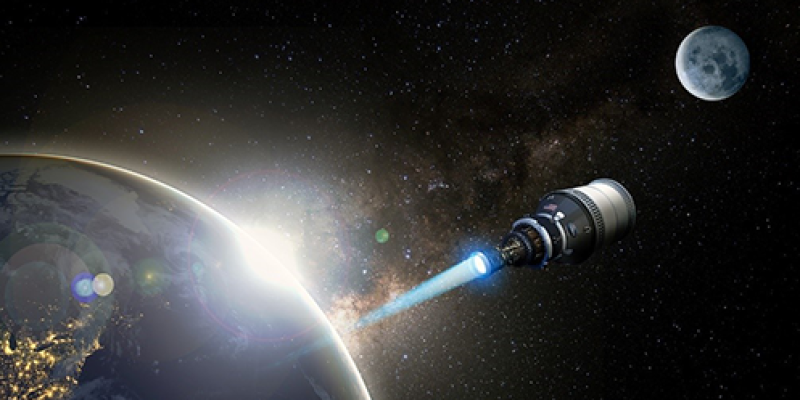The Pentagon Wants to Launch a Nuclear Thermal Rocket in 4 Years



The Defense Advanced Research Projects Agency (DARPA), the Pentagon's research and development arm, is funding the construction of the world's first nuclear thermal propulsion (NTP) system for spacecraft.
The system, which is called the Demonstration Rocket for Agile Cislunar Operations (DRACO), uses nuclear fission instead of traditional rocket fuel, making for a faster, more efficient space propulsion system. NASA sees NTP as the system that could take humans to Mars and beyond.
Earlier this week, DARPA announced it picked General Atomics, Blue Origin, and Lockheed Martin to build DRACO. The goal is to send DRACO into low-Earth orbit in 2025.
NTP is a concept that's been around for a long time. The Department of Energy (DOE) explains it like this:
NTP systems work by pumping a liquid propellant, most likely hydrogen, through a reactor core. Uranium atoms split apart inside the core and release heat through fission. This physical process heats up the propellant and converts it to a gas, which is expanded through a nozzle to produce thrust.
NTP is twice as efficient as chemical rockets, owing to the fact that lighter gases—NTP designs typically use hydrogen—are easier to accelerate. Chemical rockets produce heavier water vapor as a waste byproduct.
Scientists first proposed NTP back in the 1940s. By the 1960s, NASA and the Atomic Energy Commission had investigated the use of NTP rockets with the Nuclear Engine for Rocket Vehicle Application (NERVA) program, but canceled the project before engineers could build a working rocket. Blame unease about launching a reactor with highly enriched uranium—or plutonium—into orbit, and a sense that chemical rockets were good enough for a slowing space program.
But now, NTP's time has come.
Previously, the prospect of a nuclear-powered spacecraft exploding during takeoff and scattering dangerously radioactive materials across the U.S.—or worse, some other country—made nuclear propulsion untenable. However, modern designs rely on safer, low-enriched uranium, which poses less of an environmental risk should a chemical booster rocket carrying a NTP-equipped spacecraft suffer a catastrophic incident in the atmosphere.
The Pentagon is also pushing for spacecraft that can be repositioned in space faster than those equipped with chemical rockets. As the name implies, DARPA envisions DRACO operating primarily in cislunar space, or the area of space between Earth and the moon. NTP's higher thrust-to-weight ratio will allow spacecraft to move faster across a broader expanse of space.
If DRACO is successful, its technology could be used in the civilian space sector. NASA believes NTP could cut total durations for Mars missions by half. DRACO would then join a long line of DARPA ideas, including the internet and RNA-based vaccines, that started life as military research and development projects and then provided immense benefits to the entire world.




We have to get away from chemical propulsion. This also may allow us to "refuel" if we can find ice or liquid water on other planets or their moons.
Nuclear fueled rockets is a step up from chemical ones. But it would also introduce new safety issues. Still, it's an advancement and step forward. I'm still waiting for matter-antimatter warp drives.
They are talking about low enriched uranium, which would mean to me in the 21% or less enrichment like for the medical industry.
As far as the warp drives..... We'll probably end up creating a black hole that will swallow the Earth.
Nah
Even with uranium, there's still the issue of procuring the needed amount and associated costs. Not to mention the radiation hazards. Even radioactive medical materials are strongly and specifically monitored, controlled, handled, and disposed of. As for warp drives, a M/AM drive will not create a black hole. But a singularity drive might. Remember, some people thought the Large Hadron Collider would also create a black hole to swallow the Earth.
I remember about Hadron Colliders.... Funny, we've not heard anything out of them of late. Are they still there?
And I remember reading about the possibility of singularity drives back in the 1980s....
The Hadron Collider is rolling merrily along doing whatever it does. Haven't they found smaller particles like quarks and stuff?
They're still there and working:
How cool is that!!!!!
Great post!
They are. Although, the buzz surrounding them has died down since the discovery of the Higgs-Boson.
Yeah, probably from Star Trek: TNG, where singularity drives powered Romulan Warbirds.
Oh, boy! The Bio Shop isn't gonna like that Broken Arrow!
They have no measurable sense of humor.......
Hey...we tried but after people keep breaking things and we have to keep people from killing themselves....screw the sense of humor
Then what's your excuse Trout.....? You seem to have a splendid sense of humor.
Everyone says I'm crazy, and I remind them I'm one of the few they would let off the boat!
I got out before they could squeeze the last drop of laughter they could. And thanks for the compliment
Happy Friday Trout!
Same to you, Fly!
Awesome idea, I doubt anything will come of this anytime soon. But eventually is good enough for me
Great ideas often take time to develop and require many "baby steps." But it's the end result that matter. Today it's solid/liquid fueled rockets. Tomorrow it can be nuclear rockets. The next day it will be fusion engines. Then matter/antimatter drives. Maybe singularity drives after that? Ect., ect...
Couldn't agree more